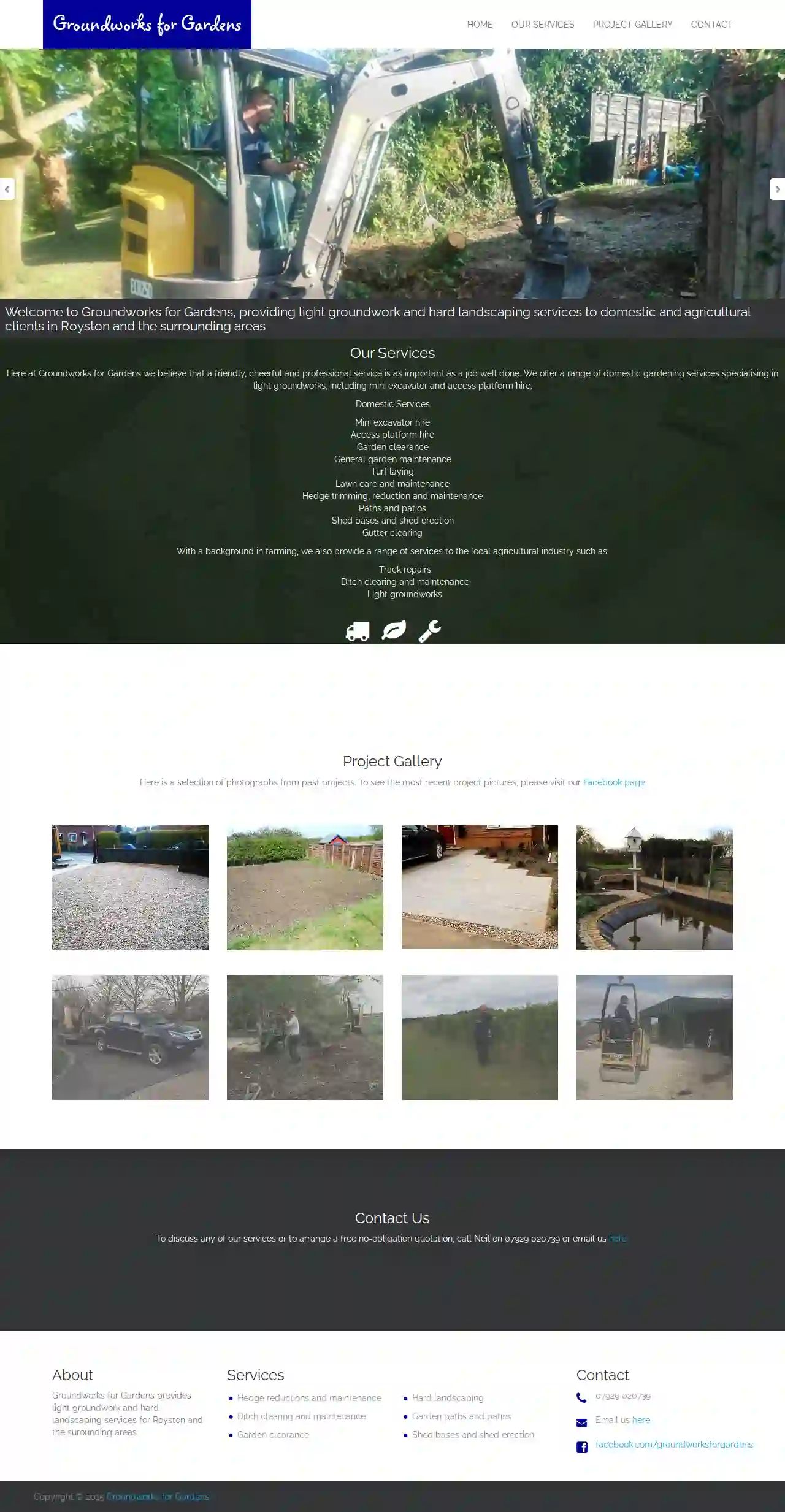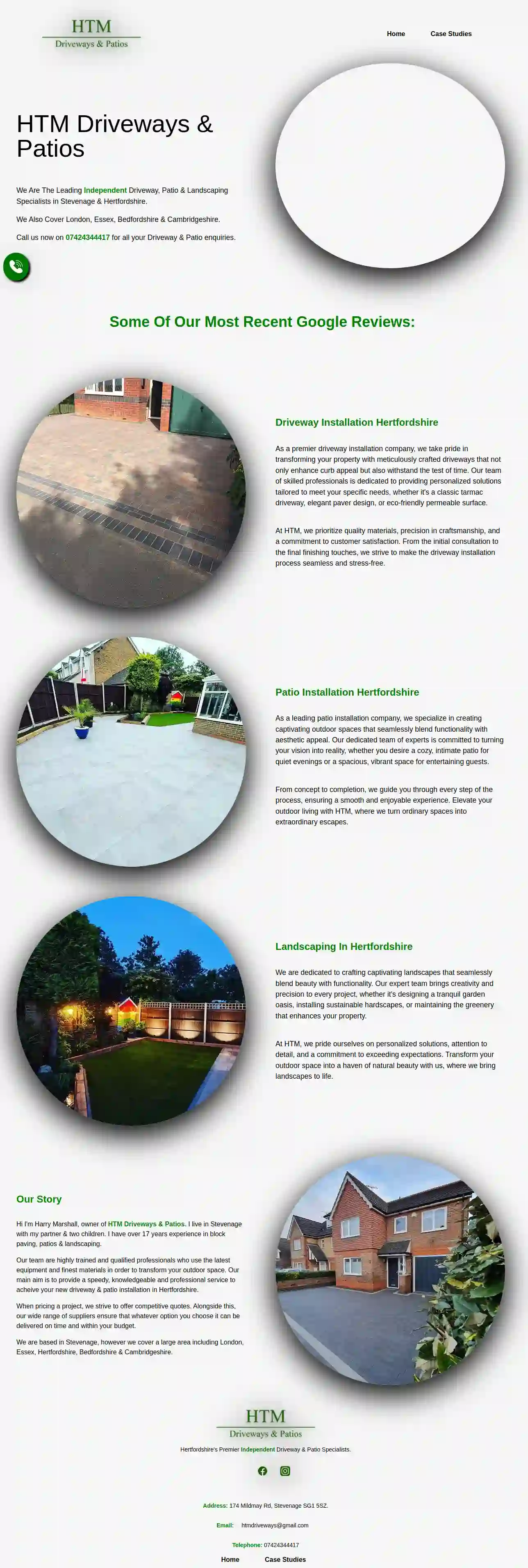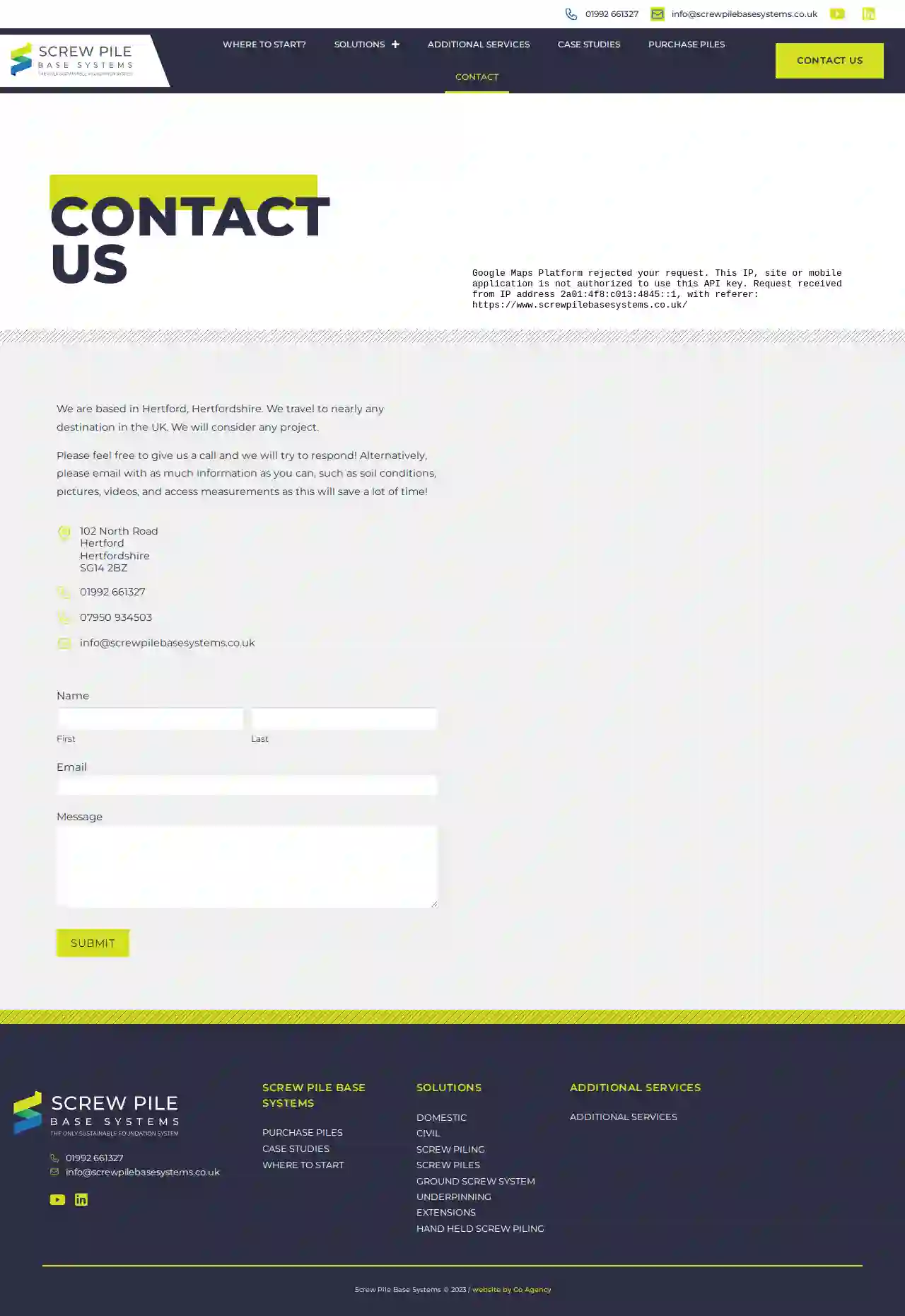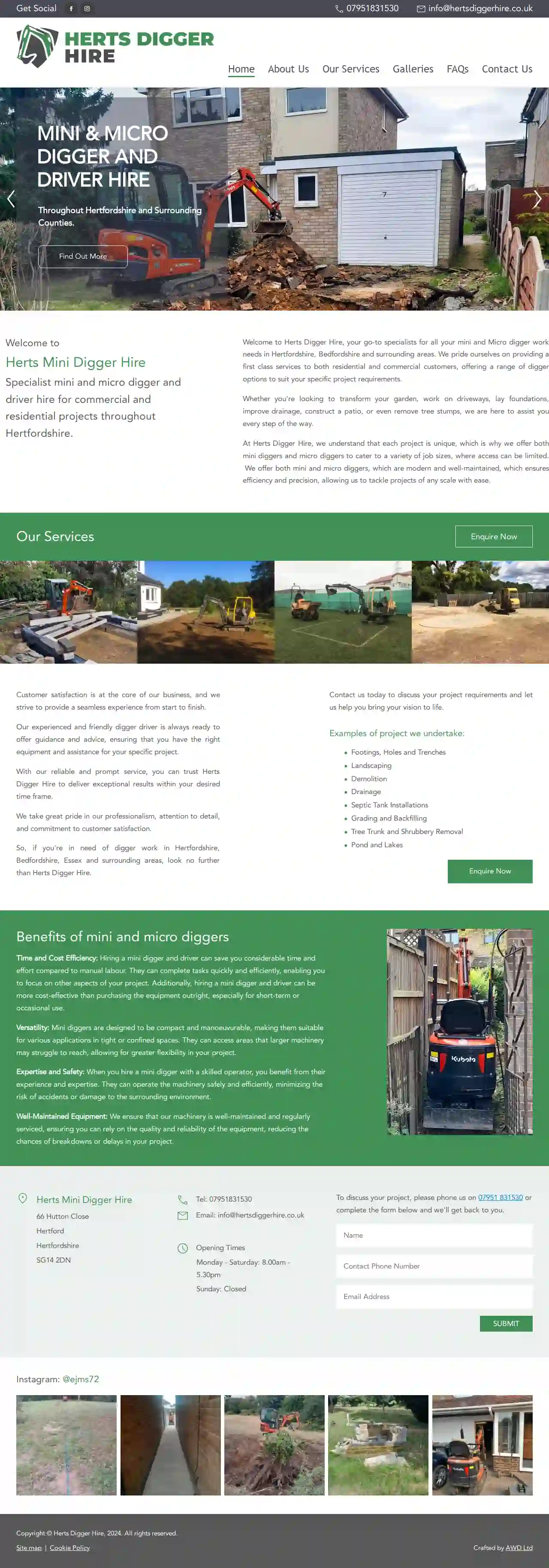excavationhq.commay be a better version of the website for you Take me there
Demolition Contractors Borehamwood
Find Demolition Companies in Borehamwood
Receive up to 3 Demolition Contractor quotes for your project today! Compare profiles, reviews, accreditations, portfolio, etc... and choose the best service.

Groundworks for gardens
56 reviewsHertford, GBWelcome to Groundworks for Gardens Groundworks for Gardens provides light groundwork and hard landscaping services for Royston and the surrounding areas. We believe that a friendly, cheerful and professional service is as important as a job well done. We offer a range of domestic gardening services specialising in light groundworks, including mini excavator and access platform hire. With a background in farming, we also provide a range of services to the local agricultural industry such as track repairs, ditch clearing and maintenance, and light groundworks.
- Services
- Why Us?
- Gallery
Get Quote
Oval Construction - House Extensions Hertfordshire | Loft Conversions | Kitchen Renovations
53 reviewsOval Construction, Letchworth Garden City, England, SG6 2NZ, GBOval Construction: Your Trusted Partner for Building & Maintenance in Hertfordshire Oval Construction is a leading provider of quality building and maintenance services in Hertfordshire, with over 25 years of experience. We are based in the heart of Letchworth Garden City and proudly serve Stevenage, Hitchin, and the surrounding areas. Our expertise lies in a wide range of services, including loft conversions, full house refurbishments, house extensions, kitchen renovations, and bathroom renovations. We are committed to delivering exceptional results by employing fully qualified and insured tradespeople. Our dedicated team covers a wide range of services, including painting, carpentry, bricklaying, plumbing, electrical work, tiling, plastering, and groundwork. We are dedicated to providing efficient, cost-effective solutions tailored to your needs. From start to finish, we prioritize superior craftsmanship and attention to detail, ensuring your complete satisfaction. Contact us today to transform your home with precision and expertise.
- Services
- Why Us?
- Gallery
Get Quote
Herts and Essex Site Investigations (HESI)
54 reviewsUnit J8, Peek Business Park, Woodside, Bishops Stortford, Hertfordshire, CM23 5RG, GBExperienced Geotechnical & Environmental engineers HESI is a well-established company based in the South-East of England and offer a wide range of Geotechnical and Environmental Services across the south of England and wider area extending to the north. HESI offer a wide range of services to a huge array of clientele and consistently strive to meet clients needs for an economical but thorough service. Our expertise provides: Pragmatic approach HESI offer a direct and pragmatic approach to site investigation providing a quick and easy service for our clientele to develop construction sites. We provide a hands on service with an energetic delivery of resources and data. Rapid response HESI can provide rapid responses to clients needs. Often a speedy inspection or site visit is required and HESI strive to meet the needs of clientele. Health and Safety HESI provide all necessary Health and Safety information to enable all works to proceed in line with best practice and can provide Risk Assessment and Method Statements for all elements of works. Discreet service HESI can provide a discreet service where required to minimise disturbance in delicate sites which may require a level of discretion.
- Services
- Why Us?
- Our Team
- Testimonials
- Gallery
Get Quote
DBacon and Son LTD
1Hertford, GBWelcome to DBacon And Son LTD Quality Comes First Our family-run construction company has been synonymous with unwavering quality, integrity, and a deep-rooted commitment to craftsmanship. With a reputation that starts from a family working together, we have built our values on a foundation of trust and an enduring passion for construction. With this long-established presence in the industry, it has allowed us to foster enduring relationships with clients, subcontractors, and suppliers. This network of trust enables us to consistently deliver projects of exceptional quality, on time, and within budget. As a well-respected name in the field, we take immense pride in our ability to bring dreams to life, whether it's creating a dream home, revitalizing a community space, or constructing a commercial landmark.
- Services
- Why Us?
- Gallery
Get Quote
Hertford Museum
4.5157 reviewsHertford, GBWelcome to Hertford Museum Discover the heart and soul of Hertford and its surrounding villages at Hertford Museum. Caring for over 100,000 fascinating objects, the museum offers a captivating journey through time. Explore collections spanning archaeology, natural history, art, geology, world cultures, social history and the Hertfordshire Regiment. There’s something to inspire everyone. Whether you’re a local resident or a curious visitor, we invite you to immerse yourself in the rich tapestry of Hertford’s heritage. A particular highlight is the Addis Company Archive, boasting the world’s largest collection of toothbrushes. Hertford Museum is a cherished community resource, which relies on the generous support of visitors and donors to maintain its vital work. With a weekly running cost of approximately £4,000, your generous contributions make a significant difference in preserving the rich and vast history of East Hertfordshire.
- Services
- Why Us?
- Gallery
Get Quote
Elliotts Drainage Solutions
4.927 reviewsUnit 13 Chells Ind. Estate, Stevenage, SG2 0LQ, GBProfessional drainage services for commercial, industrial and residential clients across the UK. From drain CCTV surveys and tanker services to unblocking and repairs, we’ve got you covered. We provide drainage services on a one-off call out basis, project works or on a retained PPM schedule for retained clients to keep your drainage systems working efficiently. WHY CHOOSE ELLIOTTS DRAINAGE? See for yourself
- Services
- Why Us?
- Gallery
Get Quote
HTM Driveways and Patios ltd
4.917 reviews174 Mildmay Rd, Stevenage, SG1 5SZ, GBHTM Driveways & Patios We Are The Leading Independent Driveway, Patio & Landscaping Specialists in Stevenage & Hertfordshire. We Also Cover London, Essex, Bedfordshire & Cambridgeshire. Driveway Installation Hertfordshire As a premier driveway installation company, we take pride in transforming your property with meticulously crafted driveways that not only enhance curb appeal but also withstand the test of time. Our team of skilled professionals is dedicated to providing personalized solutions tailored to meet your specific needs, whether it's a classic tarmac driveway, elegant paver design, or eco-friendly permeable surface. At HTM, we prioritize quality materials, precision in craftsmanship, and a commitment to customer satisfaction. From the initial consultation to the final finishing touches, we strive to make the driveway installation process seamless and stress-free. Patio Installation Hertfordshire As a leading patio installation company, we specialize in creating captivating outdoor spaces that seamlessly blend functionality with aesthetic appeal. Our dedicated team of experts is committed to turning your vision into reality, whether you desire a cozy, intimate patio for quiet evenings or a spacious, vibrant space for entertaining guests. From concept to completion, we guide you through every step of the process, ensuring a smooth and enjoyable experience. Elevate your outdoor living with HTM, where we turn ordinary spaces into extraordinary escapes. Landscaping In Hertfordshire We are dedicated to crafting captivating landscapes that seamlessly blend beauty with functionality. Our expert team brings creativity and precision to every project, whether it's designing a tranquil garden oasis, installing sustainable hardscapes, or maintaining the greenery that enhances your property. At HTM, we pride ourselves on personalized solutions, attention to detail, and a commitment to exceeding expectations. Transform your outdoor space into a haven of natural beauty with us, where we bring landscapes to life. Our Story Hi I'm Harry Marshall, owner of HTM Driveways & Patios. I live in Stevenage with my partner & two children. I have over 17 years experience in block paving, patios & landscaping. Our team are highly trained and qualified professionals who use the latest equipment and finest materials in order to transform your outdoor space. Our main aim is to provide a speedy, knowledgeable and professional service to acheive your new driveway & patio installation in Hertfordshire. When pricing a project, we strive to offer competitive quotes. Alongside this, our wide range of suppliers ensure that whatever option you choose it can be delivered on time and within your budget. We are based in Stevenage, however we cover a large area including London, Essex, Hertfordshire, Bedfordshire & Cambridgeshire. Hertfordshire's Premier Independent Driveway & Patio Specialists.
- Services
- Why Us?
- Our Team
- Gallery
Get Quote
Screw Pile Base Systems
1102 North Road, Hertford, SG14 2BZ, GBAbout us Screw Pile Base Systems has a construction history going back to 1997. The Screw pile system evolved in 2007. We searched for a better way for foundations to be created without the need for large amounts of earth removal which in turn involved large amounts of concrete. Screwpiling is at the core of our business to help create a fast, clean, environmentally sustainable, low vibration, low noise, removable, tree friendly, building regulation, fully designed way of providing a vast range of foundation base systems. Extensions Using the screw pile system makes it an ideal system for extensions or stand-alone housing. This system can either be transported though your front door or craned in if required. As the screw pile does not require any earth removed during installation the need of a party wall act can be eliminated, as you are not undermining your neighbour’s foundation. This can save huge costs and risks for yourself and neighbour! We can provide a modular build system which complies to building regulations above and beyond what’s required! A modular SIP/ Light Gauge steel (structural insulated panel) 7 times stronger than timber frame will pay for itself over its lifetime from money saved on heating bills. Hot in winter and cool in summer, this fast system of building favours what is required by today’s demanding regulations, rising utility bills and climate conditions. Minimal excavations or even no dig! Tree safe approved system! (recommend by local authorities) Through a doorway foundation building system! (If necessary) No Vibration low noise! Build Air tight and lower your heating bills! Faster with less disruption
- Services
- Why Us?
- Gallery
Get Quote
Herts Digger Hire
55 reviewsHerts Mini Digger Hire, 66 Hutton Close, Hertford, SG14 2DN, GBHerts Digger Hire: Your Go-To for Mini and Micro Digger Services in Hertfordshire Welcome to Herts Digger Hire, your trusted partner for all your mini and micro digger needs in Hertfordshire, Bedfordshire, and surrounding areas. We've been serving both residential and commercial customers since 2005, building a reputation for quality, reliability, and customer satisfaction. We understand that every project is unique, which is why we offer a range of modern and well-maintained mini and micro diggers to suit your specific requirements. Whether you're transforming your garden, working on driveways, laying foundations, improving drainage, constructing a patio, or removing tree stumps, we've got you covered. Our experienced and friendly digger drivers are always ready to offer guidance and advice, ensuring you have the right equipment and assistance for your project. We pride ourselves on our prompt and reliable service, delivering exceptional results within your desired timeframe. At Herts Digger Hire, we're committed to: Providing a first-class service to both residential and commercial customers. Offering a range of digger options to suit your specific project requirements. Ensuring efficiency and precision with our modern and well-maintained equipment. Delivering exceptional results within your desired timeframe. Prioritizing customer satisfaction and providing personalized solutions. Contact us today to discuss your project requirements and let us help you bring your vision to life.
- Services
- Why Us?
- Gallery
Get Quote
Over 3,630+ Excavation Companies onboarded
Our excavation contractors operate in Borehamwood & surrounding areas!
ExcavationHQ has curated and vetted the Best Excavation Companies arround Borehamwood. Find a top & trustworthy contractor today.
Frequently Asked Questions About Demolition Contractors
- Site Security: Secure the demolition site with fencing and warning signs to prevent unauthorized access.
- Personal Protective Equipment (PPE): Workers should wear appropriate PPE, including hard hats, safety glasses, gloves, and steel-toe boots.
- Hazardous Material Removal: Properly identify and remove asbestos, lead paint, or other hazardous materials before demolition begins.
- Utility Disconnections: Disconnect all utilities, such as electricity, gas, and water, before demolition.
- Controlled Demolition Techniques: Employ controlled demolition methods to minimize risks and ensure the structure comes down safely.
- Dust Control: Implement dust suppression measures, such as water spraying or misting, to reduce airborne particles and protect air quality.
- Emergency Planning: Have an emergency plan in place, including communication protocols and evacuation procedures, in case of unforeseen events.
- Waste Generation: Demolition generates a large volume of debris, contributing to landfill space and potentially releasing harmful substances into the environment if not disposed of properly.
- Air Pollution: Dust and particulate matter released during demolition can impact air quality, affecting human health and the environment.
- Noise Pollution: Demolition activities can generate significant noise, disturbing nearby residents and wildlife.
- Resource Depletion: Demolition consumes resources that could be salvaged and reused, contributing to resource depletion and environmental degradation.
Do I need a permit for demolition?
What is the difference between demolition and deconstruction?
Demolition: Typically involves bringing down a structure quickly and efficiently, often using heavy machinery and potentially explosives. The primary goal is to clear the site.
Deconstruction: Focuses on carefully dismantling a building piece by piece to salvage reusable materials. It prioritizes minimizing waste and environmental impact, often involving manual labor and specialized tools.
The choice between demolition and deconstruction depends on the project's objectives, budget, and environmental considerations.
What are the safety precautions for demolition?
What are the environmental impacts of demolition?
Do I need a permit for demolition?
What is the difference between demolition and deconstruction?
Demolition: Typically involves bringing down a structure quickly and efficiently, often using heavy machinery and potentially explosives. The primary goal is to clear the site.
Deconstruction: Focuses on carefully dismantling a building piece by piece to salvage reusable materials. It prioritizes minimizing waste and environmental impact, often involving manual labor and specialized tools.
The choice between demolition and deconstruction depends on the project's objectives, budget, and environmental considerations.
What are the safety precautions for demolition?
- Site Security: Secure the demolition site with fencing and warning signs to prevent unauthorized access.
- Personal Protective Equipment (PPE): Workers should wear appropriate PPE, including hard hats, safety glasses, gloves, and steel-toe boots.
- Hazardous Material Removal: Properly identify and remove asbestos, lead paint, or other hazardous materials before demolition begins.
- Utility Disconnections: Disconnect all utilities, such as electricity, gas, and water, before demolition.
- Controlled Demolition Techniques: Employ controlled demolition methods to minimize risks and ensure the structure comes down safely.
- Dust Control: Implement dust suppression measures, such as water spraying or misting, to reduce airborne particles and protect air quality.
- Emergency Planning: Have an emergency plan in place, including communication protocols and evacuation procedures, in case of unforeseen events.
What are the environmental impacts of demolition?
- Waste Generation: Demolition generates a large volume of debris, contributing to landfill space and potentially releasing harmful substances into the environment if not disposed of properly.
- Air Pollution: Dust and particulate matter released during demolition can impact air quality, affecting human health and the environment.
- Noise Pollution: Demolition activities can generate significant noise, disturbing nearby residents and wildlife.
- Resource Depletion: Demolition consumes resources that could be salvaged and reused, contributing to resource depletion and environmental degradation.
This website uses cookies for personalization and marketing purposes. To learn more please check our Privacy Policy & Cookies Policy.